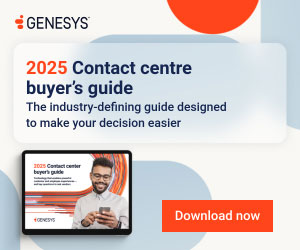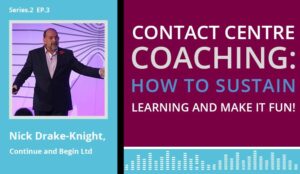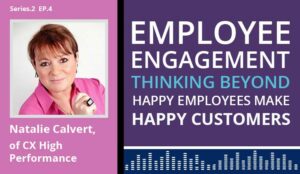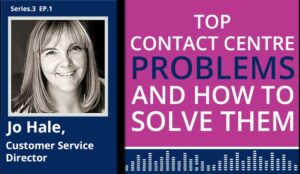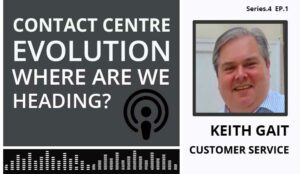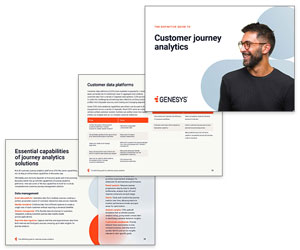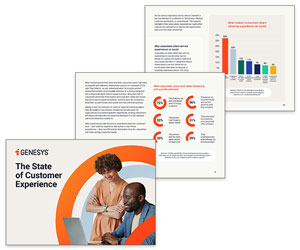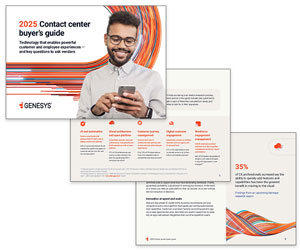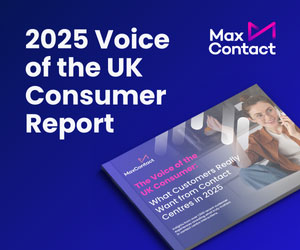The Contact Centre Podcast: Episode Nine
In this episode, Nick Drake Knight introduces us to his favourite method of coaching advisors in the contact centre, before sharing some expert tips on how to improve your training programme.

As part of our discussion, we also talk about how we can sustain key learnings from training and contact centre gamification and discuss how you can protect yourself against the “But Monster”. Yes, you read that right!
To listen to the podcast directly from this web page, just hit the play button below:
The Contact Centre Podcast – Episode 9:
Call Center Coaching: How To Sustain Learning And Make It Fun!
This podcast was made possible by our sponsor, Genesys. We now have a new link to visit their website, instead of the link mentioned in the podcast to request a demo.
So, to find out more about Genesys, simply visit their website
Podcast Time Stamps
- 2:04 – Nick’s Own Coaching Method
- 5:07 – Helping Your People to Feel Good
- 17:39 – Making Training Sustainable
- 20:15 – Employee Mindset Coaching
- 23:37 – The “But Monster”
- 29:01 – Creating Emotional Connections
- 32:12 – Using Gamification
Here is a Transcript to the Podcast
Charlie Mitchell: You have a technique for contact centre coaching called Continue & Begin Fast Coaching. What does this involve?
Nick Drake-Knight: So you’re actually right, Charlie. So Continue & Begin Fast Coaching’s been around for a while. It’s used extensively in contact centre operations. It’s used by class-leading brands every day across the world these days, and for some years now we’ve been working with global brands helping them to sustain their preferred processes, their performance standards, and behaviours. And we do that through fast coaching. So the success of Continue & Begin Fast Coaching lies really in its positivity, and the speed of its application. So it drives up performance and crucially it does it quickly. So the emphasis, the essence rather, of Continue & Begin is an emphasis on celebration. And we celebrate the call centre team member’s successes first, and then we build on that confidence, and we do that … crucially, we do that before we start thinking about development plans, and personal improvement.
A core skill of an effective Continue & Begin coach is to make careful use of language during the coaching processes, which initially stimulates that success celebration. And what we do is we use specific language patterns which are helpful in the coaching process. We also identify and isolate during training programmes some key phrases and patterns that are less helpful in the coaching context.
Charlie Mitchell: I think the key bit there is to celebrate advisor successes, and do you think this is something that sometimes contact centres don’t do enough because they feel like, oh, we have to give them some sort of reward, not just a simple thank you, which might even suffice?
Nick Drake-Knight: Well it’s more about the emphasis on improvement, Charlie. So I’ve been doing this a very long time and experienced lots of different development programmes. It seems to me that too many organizations are quick to get onto the development and the improvement ladder as a first step. Now what we know from heaps of research is that when people are being coached, certainly in the early phases, maybe the first time that they’ve been coached, they’re feeling pretty vulnerable, pretty fragile. And I guess what we do in Continue & Begin is we start by strengthening that confidence, that ego, so that they’re strong enough, they feel good enough, they feel powerful enough, resourceful enough to be able to take on additional development opportunities. But to start with that initially, how can we improve, it seems to me that that’s not a very helpful way of operating.
So you’re right, the essence of it, the emphasis initially, is let’s celebrate successes, let’s feel good about the things that you’re already doing well in your role in a contact centre. And now when your ego’s strong, you’re feeling powerful, you’re feeling resourceful, now we can start talking about how we might want to do just one or two things a little bit differently, and perhaps even better. But let’s not start with that, let’s start by helping people feel good.
Charlie Mitchell: Interesting. So do you think the starting approach of making people feel good is one of the reasons why Continue & Begin is different?
Nick Drake-Knight: Well, there’s a number of reasons why it’s different, but that’s one of the primary ones. It’s because it makes people feel good. So essentially there are four things that make Continue & Begin different. The first is that it’s fast. So it’s a far quicker coaching approach than most established methodologies. Many coaching methods, they require anything from sort of 20 minutes to over an hour to create a meaningful change plan for an individual coachee in a call centre. Now with Continue & Begin we can get substantial impact in less than two minutes and a really comprehensive change strategy within five or six minutes, depending obviously on the call centre environment and the complexity of the coachee’s ambitions. There’s the first thing, it’s really fast.
The second, as I alluded to just now, it makes people feel good. So call centre employees are much more likely to take on fresh challenges and new goals when they’re in the state of confidence and personal feel-good. And the starting point for a successful Continue & Begin Fast Coaching session is to focus on the coachee’s recent successes and a celebration of performance, when that’s measured, of course, against some kind of previously agreed standards, or rules, or ambitions. What we do, Charlie, is emphasize existing competence and capability, so the coachee’s stimulated through this process to recognize their self-worth and their self-image. And we enhance the ego and personal competence. So if you contrast that, a person who’s got some sort of impoverished self-perception, they’re much less likely to feel confident and capable or willing to take on further stretch. That’s the second reason, the feel-good.
Third is that it’s content-free. So there’s no industry- or environment-specific jargon or set of references. Continue & Begin’s used in a diverse range of circumstances, way beyond call centres and contact centres. Because it’s so flexible, there are very few, if any, scenarios where a contact centre coachee can’t be helped to further his or her competencies. So the core framework remains the same, whatever the environment, but it’s content-free; we can put anything through this method.
And finally, I guess what makes a difference is the language patterns are carefully crafted. So we talk about how the questions are specific and we use words like specificity to elicit responses that aid the coachee in achieving her ambitions, so that these patterns come from transformational grammar or other linguistic sciences, and they stimulate personal growth.
So those are the four things that make it different. It’s fast, it makes people feel good, it’s content-free, we can use it with anything, and the language patterns are very carefully constructed. Those four things together is what makes Continue & Begin different.
We’ll help brands to map out and design their preferred behaviour patterns for call centre staff. We do that at the front end of the programme, especially around customer service and sales patterns, and of course, whatever processes and guided conversations that form part of the call centre operations. So we talk about making sure the expectations around employee performance are presented as what we call explicitly described standards that everyone can understand. So there’s no ambiguity. And once these have been trained out in the call centre to the team members, once they’ve been trained out, then we can start coaching people around those standards.
Most of the world-class operators that we’ve worked with over the years use what I call the NDK Performance Model. So if you can imagine a triangle with four levels, so at the bottom, level one, we’ve got explicit standards. So these explicitly describe a set of performance standards that spell out exactly what is expected of employees. The approach applies irrespective of the discipline or the industry sector. People need to know what’s expected of them if they’re going to work to a given standard, so let’s make them explicit, there’s the starting point.
And then the second part is about achieving consistency. So I go around the world and I meet with call centre leaders and they tell me they get frustrated about inconsistency, that they’ve got some pockets of excellence, parts of the organization, parts of the operation where performance and individual standards delivery is exemplary, and they’ll say that that’s good. But it’s far from comprehensive. In fact, most of them say, Charlie, that the majority of their people are sort of doing okay. And then they sadly tell me they have a few pits of despair, where folk, no matter what support they’ve got, just don’t seem to be able to deliver to the high standards of those pockets of excellence.
But here’s the thing, we can create the consistency temporarily through effective training. Temporarily. Consistency is of limited value if it’s only temporary, because what we know is performance excellence is going to be delivered day in, day out, long after the latest training initiative has been launched. And I’m going to say this, in some organizations, and surprisingly some really impressive organizations, training is like throwing mud against the wall. Most of the mud slides off the wall immediately and leaves a puddle of brown water, a little bit of sediment on the wall, but most of it slides off. And when people leave the training room, you can see the learning falling off them as they walk out the door. And I’ve got to say, sometimes they get back to work and the line manager will ask them, “What was training like?” And they’ll say, “Well, lunch was good.”
So training’s great, and it achieves consistency, but it only does it temporarily, that’s the reality of it, but don’t let anybody from L&D hear that story. Unless, and this is where we get with coaching, Charlie, unless we can sustain that new knowledge. We can do two things, if we can do these two things then suddenly the training becomes monstrously successful, just uber successful. Here’s the first thing, first thing is the training has to turn knowledge into skill, into behaviours. If we can do that as a starting point, the second thing is having created that changed behaviour, can we sustain it, can we keep it going? Can that call centre agent, that operator, can that team member deliver the new behaviours, the new skills that they’ve learned every day, every week, every month, every quarter, every year with every call? Because if they can do that, if they can sustain that new knowledge, that new learning, suddenly the training is exceptionally valuable.
And the way that we do that is through coaching, but it has to be local coaching, and it has to be local team leaders who keep the momentum up and the training alive. Otherwise it’s a coach who flies in every week or two weeks to do some kind of momentum work. Much better if it’s the local team leader who’s doing that on a daily basis. So that’s level three, if you like, to sustainability. So we’ve got level one, the explicit standards. Level two, the consistency achieved through training. Level three is the sustainability through coaching. And level four, the tiny little bit right at the top of the triangle, I call it QCI. Certainly your listeners from a quality background will be familiar with it from total quality management days, QCI, the Quest for Continuous Improvement. And that’s about saying that what’s good today is not good enough for tod so what can we do to improve our service proposition to even higher levels? And what we do in that scenario is we get the people involved in the discussion.
So there we are, that’s in my view the answer to your question, as it fits with call centre standards. It’s about creating those explicit standards, it’s about creating consistency of delivery, it’s about sustaining them, and it’s about continually looking to see how it could be improved. Does that answer your question?
Charlie Mitchell: It does, indeed, and I think it was very interesting, those four levels, because these four levels can go beyond the Continue & Begin and just for any coaching programme that anybody puts into place. But just focusing again on Continue & Begin, how is that kind of structured within the contact centre?
Nick Drake-Knight: Well, I guess the clue’s in the title, Charlie, Continue & Begin. So let’s start with the continue to. So what we do is we identify a set of productive positive behaviours that are exhibited by the coachee and that relate to a given set of known standards, those explicit standards on level one. And then we can help the team member celebrate her existing or evolving excellence. And by doing that we can build an ego strong enough for her to take on further personal development ambitions in the form of guess what? The begin to commitment. So it’s essential that the continue tos are self-identified by the coachee, so it’s a self-assessment process, self-evaluative, and the evaluation on the self-assessment is against those explicit standards.
So once again, it’s critical that the organization maps out what’s expected so that the individual team member can then self-assess against those standards to see how they’re getting on. Rather than, and this is a real bee in my bonnet, rather than being told by the coach. There’s a massive difference between coaching and providing feedback. I’m really not into that. Self-awareness is the beginning of this. When people are self-aware, they’re much more likely to move forward. Being told, and told, and told, and told is a really inefficient way of helping people grow. So this is a … if you like, it’s a key differential, and it’s at the core of Continue & Begin Fast Coaching.
So it’s imperative the coachee is empowered by self-reflection, and our goal as Continue & Begin practitioners is to arouse, if you like, a strong psychological sense of resourcefulness and confidence before she embarks on her plans for improvement. So that’s the first of the structure, the continue to.
So you’ll recognize the second part clearly as the begin tos, and these are developmental. In many coaching methodologies, this is in my view wrongly the starting point. In Continue & Begin we don’t even consider improvement, or self-development, or remedial work until a set of continued successes have been loudly hailed and celebrated to strengthen the individual self-perceptions up. Once we’ve got a coachee confident, then we can activate the begin to phase with a small set of targeted specific ambitions. Not too many. The number of the begin tos identified is deliberately kept to a modest number, so a maximum of three ambitions for change, and in many cases I prefer just one or two key ones.
So the rationale, I guess, Charlie, for this, is sort of based on the short-term memory capacity, and the ability of people to consciously consider new ideas during performance. Sometimes we hear about people being asked to do loads of things differently; they can’t compute it in their short-term memory, on the desktop, if you like, of their mind. Therapists understand this. They call it performance anxiety. It’s exacerbated by overload. And there’s also research by a fellow called George Miller who investigated that. So in Continue & Begin, we ask the coachee to focus on just a few new ways of operating. And then the personal development plan, we ask them to concentrate just a little bit, but it makes sense for those ambitions, if they are only going to have a few of them, to be significant and value-adding, not trivial. If you’re only going to have a few, let’s make sure they’re really juicy ones.
So that’s the way we go about the structure. The continue to is to celebrate, and then the begin to is for the developmental piece.
Charlie Mitchell: Excellent. And I think there’s one bit there that I really want to pick up on, and that’s the maintaining sustainability in training, because I’m sure you’ve witnessed training classes where maybe two weeks later advisors have only remembered 10% of what was taught during that class. How can we do a better job in sustaining training in the long run?
Nick Drake-Knight: Well, you’re absolutely right, and in terms of the call centre colleagues that’s true. But think about it from an organizational point of view as well. Think about it, if you’re a senior player in an organization and you put together some significant investment in developing the training programme, and getting people to operate in new ways, fabulous new pieces of equipment are being used, but it’s not sustained. And as you say, a week, two weeks, a couple of months, maybe a year after, people have resorted to the old ways or the impact is not what it was intended to be. And the senior player in the organization, the sponsor, the investor quite reasonably says, “Well, hang on a minute, didn’t we do something on this earlier in the year? We put a significant amount of energy into this, and it’s not having the impact.” Well, no, because the training is not sustained, the new behaviours are not sustained. The coaching piece isn’t in place, or the coaching piece is so tortuous and so unpopular that people do everything to avoid it.
So it’s crucial that we get this bit right. Training’s great at creating consistency, but it’s of limited value if it’s temporary. So what we’re going to do is to create a coaching philosophy, and a skill set that allows local managers to keep the plates spinning long after the training event has passed. Sustainability through local coaching, local managers, keeps that momentum up and the training alive. So as long as the coaching experience is helpful, as long as it’s not too onerous, and dare I say, as long as it’s enjoyable, people can start to enjoy celebrating the things that they’re doing well, feeling good about their successes, and being hopeful and anticipatory about the things that they might be able to do in the future that will make their performance even better than it already is. When you can do that, then the training can be sustained in the long run.
Charlie Mitchell: I guess having a clear coaching philosophy, as you say, though, goes halfway to answering my next question, actually. But I did want to ask, what advice do you have for changing employee mindsets and getting them excited about coaching?
Nick Drake-Knight: Well, yeah, you’re right, some way through that, but let’s just think about this. So I mentioned it earlier, too often, Charlie, coaching is camouflaged in name because it’s really feedback, and feedback isn’t coaching. And too many folk have been through that painful experience of being told, often with best intention, that the things they’re doing well, and that they should, need to, have to, got to, ought to improve on. So feedback is didactic, it’s an imposition of will, it’s forceful. It should not be about that. We’ve got to change that perception, because coaching becomes popular, people enjoy it, they get a buzz out of it, they’re saying, “Hey, why haven’t I had a coaching session recently?” They start to operate in this really dynamic, forward-thinking developmental way when it’s experienced as a positive, value-adding, ego-strengthening activity. Because when people feel good, when they leave the coaching conversation feeling better than when they started, that’s when organizational culture begins to change.
So we know people grow best, they develop best, when they want to. Not when they’re forced to. So when the focus starts with a celebration of success, we change the thinking paradigm. When we focus on what’s wrong in our lives, we shut out positivity and opportunity. We start focusing on what’s not being done properly, we shut down that enthusiasm. So you transfer this reality to the world of coaching and we create this kind of stunted thinking and limited possibilities. In fact, there’s some recent research in the last few years analysing brain image patterns, and it highlights how important it is to think productively about potential outcomes rather than current limitations. And this is the essence of Continue & Begin Fast Coaching. And you can read the research at Harvard Business Review. There’s a number of pieces there, but essentially it illuminates and it emphasizes that thinking in a positive developmental sense is far more productive in terms of changed behaviour than identifying what’s not being done so well.
Charlie Mitchell: There’s a number of interesting points there that you mentioned, and one of them was that a lot of the existing coaching models aren’t even coaching models at all, but they’re ways of giving feedback. So I’m thinking two stars and a wish, or there’s a model itself called the grow model, and that’s not actually helping people learn, that’s just a way of giving people feedback through real-time coaching. I thought that was a very interesting point before I move on to another thing that I’ve heard you speak about, and that is something called the “But Monster” in a previous presentation. Do you just want to let our listeners know what you mean by this?
Nick Drake-Knight: Yeah, sure, and just before we do that, I don’t want to diss other coaching models because, generally speaking, they all have a place, it’s just that I believe that they’re not always as productive as they could be. I think they’re too lengthy. I think they’re convoluted. And I don’t think they have the same rapid impact, and I don’t think they make people feel as good as Continue & Begin, but let’s not diss them.
So yeah, the But Monster. Yeah, this is fun, listen to this language pattern, okay? Call centre, right? “Well, you did pretty well on that call, some of the things you did were … they were helpful.” Now, Charlie, what word is coming next? What is it I’m about to say?
Charlie Mitchell: “But … “
Nick Drake-Knight: Yeah, see you know, we know intuitively, we understand the next word’s going to be but. Let’s run it again. “Well, you did pretty well on that call. Some of the things you did were … well, they were helpful.” You just know the next word’s going to be but, don’t you? So, but here’s the interesting bit, how did you know? How did you know? Well, here’s the thing. You know because of the tonality of my voice, you know because … well, if you could see me, you’d know because of the physiology that I illustrate with my facial expression, and my breathing patterns, and everything else. And you’ve heard and experienced these types of communicating many times in the past, Charlie, haven’t you?
Charlie Mitchell: Too many.
Nick Drake-Knight: You know that the next word that’s coming out is going to be a but. Now, what’s coming after the but? Well, you know, you understand, intuitively you know the next thing that’s going to be coming out is some form of criticism, some form of request for change, some sort of negative vibe. And you’re getting ready for it. So just try it again. “You did pretty well on that call, some of the things you did were … well, they were helpful.” You know a but‘s coming, Charlie, don’t you?
Charlie Mitchell: Yeah.
Nick Drake-Knight: But you know that after the but there’s going to be some request for change, it’s what I call the But Monster and it’s coming to bite you on the buttock.
So the But Monster, what it does, it stops people from feeling good, and it gets them ready for some impending pain. Which is absolutely not what we want to do for Continue & Begin Fast Coaching. So remember, we want people to feel good. And if you start to use the word but, all of those natural downward inflections in the voice, all of the physiology and the tonality gives the game away before you even say the word but, and then inevitably is that request for change.
So my guidance to you, and I think in the piece that I wrote for you so many years ago, remove the But Monster from your coaching vocabulary, change the way that you help people to change. And if you want them to operate in a different way, use a different way of communicating. So I remember in the first piece I wrote for you all those years ago about the But Monster, there were people writing in and saying, “Well it’s okay saying don’t use the But Monster, but what can we use?” Well, there’s a great way of operating, so instead of using the But Monster, we use the word and. And we keep the tonality up, we keep the facial expressions and everything else about the body language really positive. So here it goes, back in the call centre coaching session, “Hey, Charlie, some of the things on that call this morning were fantastic. You’ve done some great stuff. And what would be really great as we progress is if you could also make the change.”
Now, you’re hearing this, there’s still a request for change, and instead of the But Monster, there’s an and. You may not even have heard it, it was slick, right? It was quick. So there’s a difference between the But Monster and and. And you can use a similar approach if you like. And instead of using and we simply break the sentence into two with a full stop and a deep breath and a swallow in the middle of the two ideas, the current idea, the current performance, and the future idea, the future performance. So here it goes, “Hey, Charlie, some of the things on that call this morning were fantastic. You’ve done some really great stuff.” Full stop, deep breath, swallow. “And what’d be really great as we progress is if you could also … ” You get the idea?
Charlie Mitchell: Yeah.
Nick Drake-Knight: So we have the first idea and we just simply stop, “You’ve done some great stuff.” Full stop, deep breath, swallow. “What would be really great as we progress is if you could also … ” So the and, and the full stop. But approach is with the increased upward tonality, the positive physiology, everything around that, we simply avoid the But Monster and it’s a technique that’s used extensively, by the way, in therapeutic contexts. Because some therapists know that but can jolt a patient out of feelings of comfort and relaxation. In fact, what it does, it creates anxiety. That’s why they avoid the But Monster. And we don’t want our Continue & Begin Fast Coaching team members feeling anxious, because anxiety is an inhibitor to learning.
Charlie Mitchell: Excellent stuff, and I think that’s not only a piece of advice for contact centre coaches, but maybe that’s something that can be taught to advisors as well to make sure they don’t pass any feelings of anxiety on to customers, so I think it’s all around a brilliant tip. And just picking up on that emotional aspect of these feelings of anxiety and things, that we hear a lot about how we should behave as advisors in terms of creating an emotional connection with customers. What advice do you have for advisors, for coaches wanting to teach advisors, for creating emotional connections with customers?
Nick Drake-Knight: Well, firstly, you’re absolutely right, the But Monster and the avoidance of it is transferable to the world of communication with customers. And a lot of my work around customer service and sales work, we focus in on language patterns and the impact it has on people at an emotional level. So you’re absolutely right, the two think together. So in my book Meerkat Selling and also my most recent book, Fast Coaching, I talk about something called the emotional driver. And what we have here is the reason for all human behaviour. That sounds pretty profound, and it’s true. Everything we do is driven by an urge for feeling, and it’s a truism, that all human behaviour has a positive intent. Let’s just say that people do things for a reason.
So behaviour’s driven by an underlying emotional need. Every single thing that we do, no matter how trivial, is driven by an emotional need, what I call the emotional driver. And it encourages us to make either a movement towards emotional pleasure, emotional comfort, emotional feel-good, or the other underlying emotional need is a move away from existing physical or psychological discomfort or pain. And importantly, also not only existing pain and discomfort, but also anticipated pain or discomfort. So we’re driven by an urge either to have some nice feelings or to avoid having nasty feelings. Behaviours are driven by our emotions.
Incidentally, in terms of buying behaviour, you think about every single thing that you’ve ever bought, every single thing, no matter how trivial, it’s driven by an urge either to have some pleasure or comfort, some feel-good, or it’s driven by an urge to avoid feeling bad. In the sales world, in the customer service world, this is profound in its impact. A lot of my work is around that. So hey, you know better than me, I guess, but experienced call centre colleagues know all about emotional customers, right? So there are these two types, moving away, including the fear of potential future pain, moving toward feelings of relaxation, feelings of comfort, feelings of contentment.
Now, this is really important, one of those drivers, one of them, will be the initiating force or the dominant force. Sometimes it’s both, but one is the initiating or the dominant force in customers’ minds, in their hearts, when they’re seeking some form of resolution. Either the reason for the call, for making the call to the call centre, or for accepting an outbound call. But here’s the question, Charlie, here’s the question. Which driver is it, which emotional driver is it that’s causing the customer either to accept the call or to make the call? Is it moving away from pain, or is it an urge to move towards pleasure? So a key skill for call centre professionals is to uncover, as best they can, the emotional driver of the customer. What is the feeling that she wants to move away from? Or what is the feeling that she wants to move towards? These are critical questions to consider.
But what we can do, is we can gain clues from the customer by listening carefully, and there’s no better medium for listening carefully than a call centre. Listening carefully to the words that they use, and the evidence that he or she offers. So in my books, and I think also in some of the Call Centre Helper articles I’ve written for you guys over the years, I talk about using clean language to build a rapid rapport, and how a good set of questions, including something called The Permission Question, is incredibly powerful. The Permission Question, how these approaches can help in uncovering the primary, initiating, or most dominant emotional driver of the customer.
So it all comes down, really, Charlie, to rapport and to questioning.
Charlie Mitchell: Excellent, and just for some of our listeners who may be unaware, what does The Permission Question involve?
Nick Drake-Knight: The Permission Question is precisely what it says. So what we do is we very simply ask the customer, whether it’s a customer service environment, or a sales environment, or any other scenario, we ask the question, “Charlie, just so I can help you, would it be okay if I ask you a few questions?” That’s The Permission Question, and it’s rare, very rare that the response is, “No, I do not wish you to ask me any questions.” Normally, of course, the answer is, “Yeah, sure, fire away.”
Charlie Mitchell: Yeah, excellent, and I imagine that question is actually, as you say, very insightful in terms of which emotional driver the customer has for making the call. But just one final topic that I want to focus on today is a very in topic within the context of industry at the moment. And that’s gamification. Have you had any experience with using gamification for contact centre coaching?
Nick Drake-Knight: I love gamification.
Charlie Mitchell: Oh, wow.
Nick Drake-Knight: I love anything that brightens up the day, eh? I’ve got to say my favourite’s Bingo, I’m sure lots of people use it, but it’s still my favourite. One of my clients in Chicago, it’s a global brand, they’re involved in adventure clothing, a well-known brand. But one of the country managers in Chicago started using Bingo within her coaching team. And what she was doing, she was checking off some of the key Continue & Begin phrases and language patterns that were being used by her coaching colleagues, and four corners, and a line, and a full house and all that sort of stuff. It’s a lot of fun. A lot of … all around the world, my global clients, they use games to stimulate the use of sales and customer service language patterns, and it’s a lot of fun. It’s really crazy to see Bingo sheets or any other game, it’s crazy to see them in so many languages too. I was in Oslo recently with country managers all over the world, and I’ve never played Bingo in Hungarian before. And yes, I know Oslo’s in Norway.
Charlie Mitchell: I was about to pull you up on that, but, yeah. You got there. Excellent stuff, and there’s also gamification software, which I’m sure our sponsor, Genesys, can help you with.
Nick Drake-Knight: Oh, great.
Charlie Mitchell: See what I did there, Nick?
Nick Drake-Knight: Yeah, I’ll take a look at that.
Charlie Mitchell: Excellent, excellent. And just as a final kind of caveat for our listeners, where can they find out a bit more about the coaching techniques that you’ve discussed today, and maybe where can they even get in contact with you after listening to this podcast?
Nick Drake-Knight: Oh sure. continueandbegin.com. They can get onto the website there. Have a play around on YouTube, there’s … I don’t know how many films on there. Or drop me an email, Nick@NDK-Group.com. Or just put my name into the internet and I’m sure stuff will come up. I’m on LinkedIn as well if guys want to have a chat via that medium.
Hey, but finally, good luck to everybody in their coaching ambitions, because this is so important. We go back to that triangle, explicit standards are great. Consistency is great, but it’s temporary. Sustainability is what it’s all about. And we’ve got to continuously improve if we’re to stay ahead of the game. So I wish everybody great good fortune in their coaching activities. If anybody wants to have a chat, get in touch, I’m happy to talk.
Charlie Mitchell: That’s all for this episode. Thank you to Nick Drake-Knight for joining us today. His latest book, Fast Coaching, the Complete Guide to Continue & Begin, is now available on Amazon, or you can also find the audio version exclusively on Audible.
Author: Jonty Pearce
Reviewed by: Jo Robinson
Published On: 28th Oct 2019 - Last modified: 10th May 2024
Read more about - Podcasts, Charlie Mitchell, Coaching, Genesys, Nick Drake-Knight




